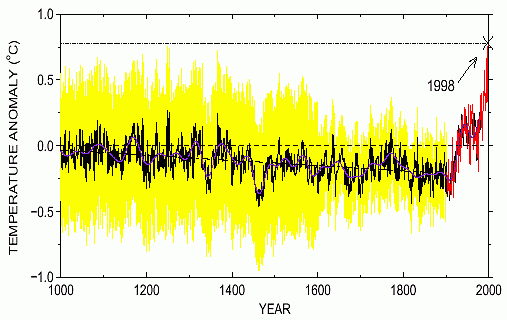The plots of global temperature changes prior to 1860 (i.e., before the period of instrumental records) provided in the previous lecture pages and in an in-class handout should not be interpreted as a literal and exact reconstruction of global average temperature changes. There is a great deal of difficulty and uncertainty in trying to reconstruct global average temperature changes based on proxy data. One thing we can say with some certainty is that global average temperatures have fluctuated all throughout Earth's history, including the last 2000 years. Prior to 1900, we can safely say that the changes were not caused by anthropogenic additions of greenhouse gases, but were natural fluctuations.
The plots provided to you are only one estimation for global average temperature change and do not give you any indication about the uncertainty. Other research groups have come up with different reconstructions based on their interpretation of available proxy evidence for global average temperature changes. The figure below gives some indication of the unceratainty as it shows 10 different published global temperature reconstructions for the last 2,000 years (note that most of the reconstructions shown only go back about 1,000 years). The point here is that there is not one single correct reconstruction.
![[Temperatures of the Last 2,000 years]](2000_Year_Temperature_Comparison.png)
|
One of the most controversial (and often referenced) reconstructions was first released by Michael Mann and co-authors in 1998 (shown below). This particular reconstruction has been labeled the "Hockey stick" because of the hockey stick shape of the trend lines: gradual cooling from 1000 - 1900 AD, followed by a sharp warming after 1900. This reconstruction turns the medieval warm period and little ice age in non-events globally. (NOTE: based on written historical evidence, we can be fairly certain that these periods were relatively warm and cold throught much of Europe. Mann's study indicates that global average temperature did not behave like that of Europe.)

|
| "Hockey stick" reconstruction of global average temperature changes over 1000 years (ending in 1998). Reconstruction performed using proxy data before 1900 and instrumental data after 1900. Yellow and red shading show author's estimation of uncertainty in the reconstruction. |
It is difficult to decide which, if any, of the reconstructions of global mean temperature is an accurate reflection of temperature fluctuations during the last 1000 years. However, it is likely that such reconstructions, accurate or not, will play a significant role in the ongoing discussions of global climate change and global warming.
If you "believe" the temperature reconstruction presented in the in-class handout, then global average temperature during the medieval warm period was nearly the same as it is today. This may lead some to conclude that the present warm conditions are not extraordinary when viewed in the context of the last 1000 years. In other words there are recent natural climate fluctations with global average temperature very close to what they are today.
If you "believe" the hockey stick reconstruction, then the current global average temperature is much warmer than at any time over the last 1000 years. This can lead to the conclusion that the conditions today are extraordinarily warm compared with the recent past and most likely can be attributed mainly to anthropogenic greenhouse gas increase.
We certainly cannot resolve this issue here. There is lively debate on both sides even among the "experts". For example, many climate scientists who have come to the conclusion that much of the recent temperature increase can be attributed to the increased greenhouse gases dispute the hockey stick reconstruction, saying that the medieval warm period and little ice age should show as significant periods in global average temperature reconstruction. Some have gone so far as to make the accusation that Mann's method of analysis pushes the results toward the "hockey stick" shape. Conversely, other recent and independent reconstructions of global average temperature seem to confirm Mann's results. In any case, all reconstructions of global average temperature based on proxy data are so uncertain that one cannot be used to disprove another. As with many other issues in the global warming debate, we are forced to decide how to act based on uncertain information.